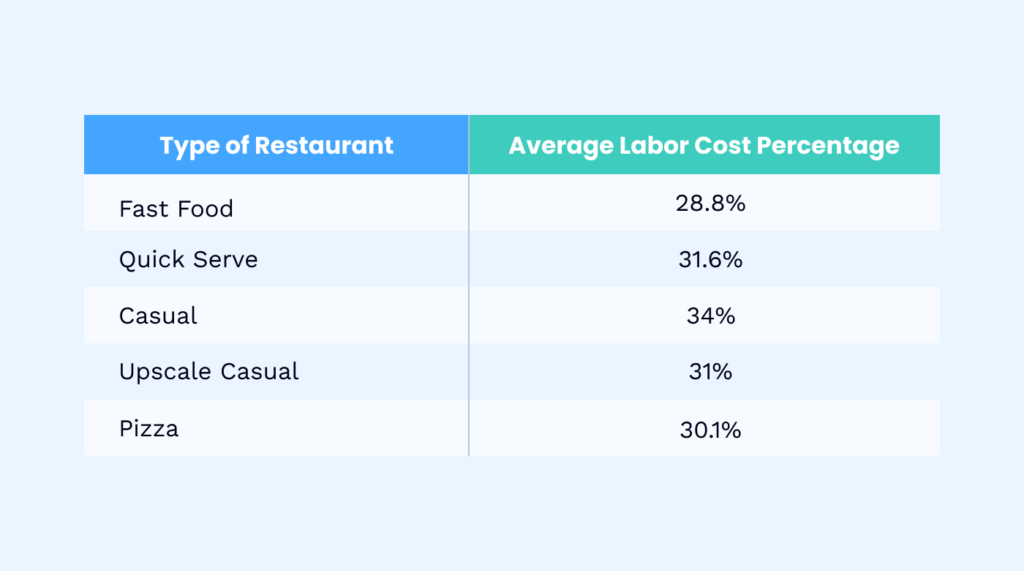Employees are the backbone of your restaurant. At the same time, paying their wages and salaries will be one of your most important expenses as a business owner.
A low restaurant labor cost percentage is an indicator of a healthy business. And if you don’t keep your restaurant labor costs under control, they’ll eat up your already razor-thin profit margins and hurt your business performance.
It’s why in this article, you’ll learn how to calculate your restaurant labor cost percentage, along with strategies you can use to drastically reduce it.
What’s Your Restaurant Labor Cost Percentage?
Your restaurant labor cost percentage is how much your business spends on your employees compared to your gross sales revenue. Restaurant labor costs include the following:
- Hourly wages and salaries: How much you pay your restaurant employees.
- Overtime pay: The pay you provide to employees that work beyond their regular work hours.
- Restaurant payroll taxes: Taxes that both you and your employees have to pay.
- Healthcare: This includes any healthcare benefits you provide employees, such as dental/vision coverage, medical insurance, and wellness employee benefits (like discounts on gym memberships).
- Paid Time Off (PTO): Compensation for your employees’ sick days and vacations.
The purpose of calculating your restaurant labor cost percentage is to help you make better business decisions.
For example, after calculating your total restaurant costs, you may realize that you’re overspending on labor and need to make some budget cuts. Or, that you have a big enough budget to grow your team and hire more people.
How Do You Calculate Labor Cost in a Restaurant?
Calculating your restaurant labor cost percentage starts with a simple formula.

Here’s how you can determine your restaurant labor cost percentage in four steps:
- First, you must calculate your restaurant labor cost percentage across a specific period of time. Choose a time of the business year that you want to analyze. For example, time periods you can measure could be an entire year or a quarter.
- Identify how much you had to pay for your employees during that period. That includes the total sum you had to pay in wages, salaries, healthcare benefits, and payroll taxes.
- Calculate your total gross revenue in food sales from your restaurant for that specific period.
- Next, use the following formula to calculate your restaurant labor costs: (Total labor costs / gross food sales) X 100
Let’s use an example to demonstrate how this restaurant labor cost formula works in real-time.
Across a period of 90 days in the first quarter, you paid your employees a total of $9,000 in labor costs. During that time, you generated $20,000 in food sales revenue.
Based on these figures, this is how we’d calculate our total restaurant labor cost percentage:
$9,000 (total labor costs) / $25,000 (gross food sales) X 100 = 36
As a result, you’d have a restaurant labor cost average of 36%.
Average Restaurant Labor Cost Percentage per Industry
As a restaurant manager, you may wonder how your restaurant labor cost percentage holds up to others in your industry. Or what your ideal restaurant percentage labor costs should look like.
The general average labor cost in the restaurant business is 31.6%. However, what qualifies as a “good” labor cost depends on the type of restaurant you manage. Here are the typical labor costs for different restaurant types from the accounting firm BDO:

There are various reasons why restaurant labor costs differ so much from industry to industry.
Fine dining restaurants, for example, have higher labor costs because they require staff with experience and specialized chefs. On the other hand, fast food restaurants have low labor costs since the food is more immediate to prepare, and employees can serve customers quickly.
So what is a good labor cost percentage for a restaurant? If your current restaurant labor cost percentage is lower than the average in your industry, then you’re doing pretty well. If not, then you’ll need to make some adjustments to your budget.
Four Strategies To Reduce Your Restaurant Labor Cost Percentage
With the right strategy, you can keep your restaurant labor costs under control and remain profitable. Here’s what you can do to lower labor costs and drive more net revenue:
Make employee retention a priority
The restaurant industry has a high employee turnover rate, with rates as high as 144% for sectors such as the fast food industry. Research from Alignable also shows that 83% of restaurants can’t find enough workers.
Often hiring and training new staff hurts your revenue in the long run. According to Edie Golberg, president of E.L. Goldberg & Associates, in a discussion with Yahoo Finance: “The real cost of turnover is often estimated to be 33% to two times the employee’s annual salary.”
So, for example, if your chef’s annual salary is $40,000 and they leave, it could cost you up to $80,000 to replace them.
It’s why you should maximize your employee retention rate as much as possible. That way, you don’t lose time and money replacing your staff each time someone quits.
To prioritize employee retention in your restaurant, start by listening to your team and their needs. What concerns or complaints do they have? What do they need to do their job more effectively?
Their feedback should provide insights into what you can do to improve their work experience.
Cross train your restaurant employees
Hiring different employees for different restaurant roles can quickly increase your business labor costs. It’s better to focus on cross-training your restaurant employees instead to make savings.
Cross-training your staff allows them to learn the skills they need to cover different shift types. As a result, you won’t need to hire a new person for each shift. On top of helping you save money, cross-training is also a great way to invest in your employees and help them with their professional growth.
Another benefit is that if an employee calls in sick and can’t attend their shift, one of your cross-trained employees can pick up their responsibilities instead.
Minimize employee overtime
Too much overtime can stress your employees and increase your restaurant labor costs. Make sure to keep overtime at the bare minimum so you’re not overspending on labor costs and driving employees to burnout.

One way to minimize employee overtime is to write down an overtime policy. The policy should make it clear to employees when they’re allowed to work overtime and how many hours per week they can work.
That way, you can drastically reduce the number of your employees’ excess hours.
Another way to not overspend on overtime is to know your state’s overtime laws. If employees work more than local law allows, your business could receive hefty penalties and fines.
It’s also important to forecast your staffing schedule during busy periods of the year. For example, if you predict you’ll have a busy night on Thanksgiving, ensure you have the correct staff available for that time period.
Otherwise, employees may have to work longer hours to meet the demand, resulting in higher overtime pay.
Invest in restaurant employee management software
Restaurant employee management software can lower labor costs by eliminating manual tasks and managing your work schedule better. For example, with a tool such as Connecteam, restaurants can:
- Set up training courses so employees learn all the skills they need to deliver the best service and improve customer satisfaction. You can also keep your restaurant knowledge, such as recipes and employee handbooks, all in one place.
- Improve employee retention by praising workers with tangible rewards and badges for their hard work. According to the 2022 Engagement and Retention Report from Achievers Workforce, 72% of employees say that being rewarded frequently improves their morale in the workplace.
- Gain access to our Scheduler and Time Clock, which makes it incredibly easy for managers to plan shifts, see scheduling conflicts, and allow employees to swap shifts when needed.
- Ensure that work hours are 100% accurate, so you’re not overspending on payroll with our overtime tracker. Our automation software will calculate overtime hours and produce error-free timesheets to track your employees’ workload accurately.
By automating your manual scheduling tasks, you’ll have more time to focus on what matters the most: growing your restaurant business.
Keep Your Restaurant Labor Costs Low To Stay Profitable
Labor costs that are too high hurt your restaurant’s revenue. But with the right strategies, you can keep costs under control and keep your business financially healthy in the long term.
It’s all about putting the needs of your restaurant employees first, providing them with the correct training, and proper staff scheduling to minimize overtime.
To manage shifts, you could try to keep track of your team’s schedules with spreadsheets. However, using software that automates the whole process is much more efficient: it reduces errors and provides insights on how you can improve your staffing.
Get started with Connecteam for free today to streamline your restaurant’s most repetitive operations.



